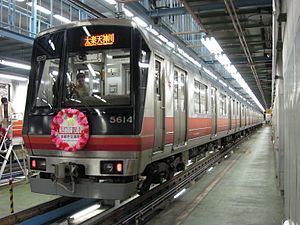Opened October 12, 1997 | Stations 17 | |
 | ||
Website www.city.kyoto.lg.jp/kotsu | ||
The Tozai Line (東西線, Tōzai-sen) is a Kyoto Municipal Subway line which runs from the southeastern area of the city (starting from Rokujizo Station), then east to west (i.e. tōzai in Japanese) through the Kyoto downtown area. The Kyoto Municipal Transportation Bureau operates the system along with the Karasuma Line and the City Bus. The present terminal stations are Rokujizo Station in Uji and Uzumasa Tenjingawa Station in Ukyō-ku, Kyoto. It handles an average of 120,000 passengers daily.
Contents
The stations are wheelchair-friendly, with elevators, narrow gaps between platform and train, and no height differences at places like rest rooms. Each station has a color code for easy recognition. All platforms on the line are island platforms, and have platform screen doors separating the platform from the tracks.
The line is 17.5 km long with a track gauge of 1,435 mm (4 ft 8 1⁄2 in). The entire length is double-track. Trains are electric, operating on 1,500 V DC.
On October 12, 1997, the section the line from Daigo to Nijō opened. On November 26, 2004, the line from Daigo to Rokujizō opened. An extension westward from Nijō to Uzumasa Tenjingawa began service on January 16, 2008.
Events leading up to construction
After World War II, the Kyoto Municipal Transportation Bureau discussed the possibility of creating a new municipal streetcar system, connecting Rokujizō, Daigo, and Keage, before cutting along the center of Oike-dōri (an elevated line was also considered). Before long, the proposal was at an impasse in the face of ever-increasing automobile use in the city. However, the plan was eventually reworked as a subway line.
The population along the east-west route showed a considerable trend of growth, but road development in the vicinity could not overcome traffic congestion, so a plan for transportation facilities connecting the eastern part of the city (Yamashina-ku and the eastern portion of Fushimi-ku) with the city center was developed starting in 1965, and it was officially approved by the city government in 1969. The construction of the segment from Daigo to Nijō was set to start in 1975.
At that time, however, the Keihan Keishin Line ran above-ground between Misasagi and Sanjo Keihan along the planned route, and the issue of competition arose. As a result of negotiations, Kyoto City and Keihan Electric Railway agreed to establish a Third Sector (public-private partnership) company to obtain a Type-3 railroad business permit and control the tracks, while the City of Kyoto would obtain a Type-2 railroad business permit and operate the trains on that section. Thus the Kyoto Rapid Railway Corporation was born. Founded in 1986, then-mayor Masahiko Imagawa assumed duties as its president. Kyoto Rapid Railway constructed the subway through the Japan Railway Construction Group, and along with the Keihan Keishin Line's incorporation, the above-ground section was set to be eliminated.
Over the course of construction work underneath Kyoto, the project faced frequent, unavoidable interruptions due to discoveries of remains and ruins, and experienced difficult work in tunneling underneath the Kamo River and Tōkaidō Shinkansen. The section from Daigo to Nijō opened in 1997, and the Keihan Keishin Line was integrated from Misasagi to Kyoto Shiyakusho-mae.
The reason that the Keishin Line does not terminate at Sanjo Keihan as it originally did when above-ground, is that the necessary amount of space for a returning track could not be provided (not only is there a sharp curve directly to the west of that station, but the extra dead-end track would be directly underneath the Kamo River, so it was not feasible). The reason it did not originally continue to the (then-)terminus at Nijō was for the Kyoto Municipal Transportation Bureau to keep the calculated costs of running the trains balanced. However, since the opening of the extension in 2008, this is no longer the case and trains of the Keishin line now continue all the way to the present terminus at Uzumasa Tenjingawa.
When the above-ground Keishin Line portion was demolished, Kujōyama Station and Hinooka Station (which have no subway counterparts) were demolished as well. City residents who lived near Kujōyama Station demanded that there be a Kujōyama subway station, but due to anticipated difficulties in construction, as well as an insufficient estimated number of riders, this request went unfulfilled.
Extension west
A plan exists to extend the Tōzai Line as far west as Rakusai in Nishikyō-ku, but for the time being, extension will be stopped at Uzumasa Tenjingawa; prospects beyond that are as-yet still unclear. There are several issues to be considered:
